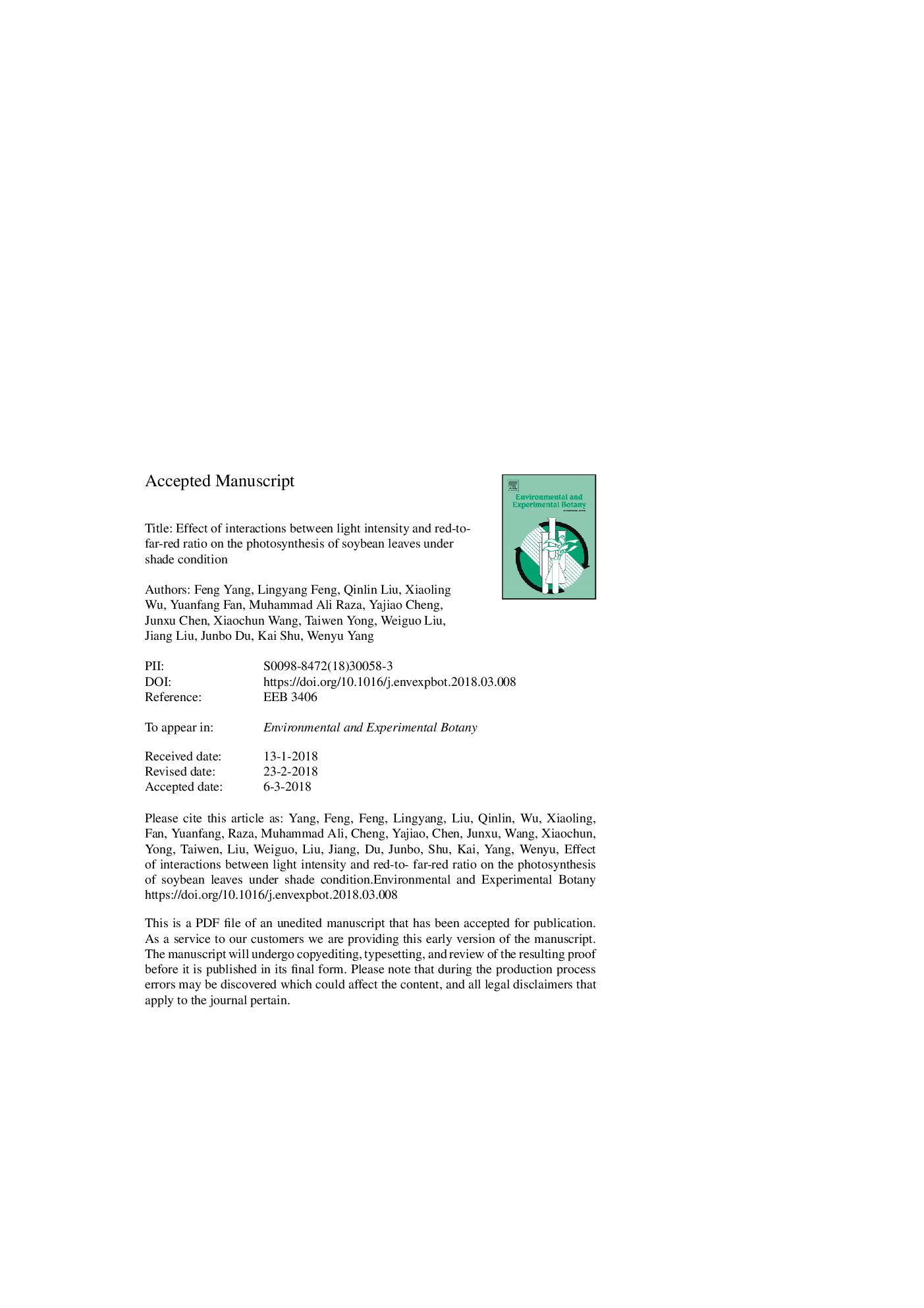| کد مقاله | کد نشریه | سال انتشار | مقاله انگلیسی | نسخه تمام متن |
|---|---|---|---|---|
| 8886984 | 1628027 | 2018 | 26 صفحه PDF | دانلود رایگان |
عنوان انگلیسی مقاله ISI
Effect of interactions between light intensity and red-to- far-red ratio on the photosynthesis of soybean leaves under shade condition
ترجمه فارسی عنوان
اثر تعاملات بین شدت نور و نسبت قرمز به قرمز به فتوسنتز برگ های سویا تحت شرایط
دانلود مقاله + سفارش ترجمه
دانلود مقاله ISI انگلیسی
رایگان برای ایرانیان
کلمات کلیدی
سویا، فتوسنتز، کلروپلاست، کشت مخلوط، تجزیه پروتئومیک،
موضوعات مرتبط
علوم زیستی و بیوفناوری
علوم کشاورزی و بیولوژیک
بوم شناسی، تکامل، رفتار و سامانه شناسی
چکیده انگلیسی
Photosynthesis is dependent on the density and quality of light that reaches chloroplasts. Shade conditions are characterized by changes in light density and quality. These changes, which are represented by the red to far-red (R/Fr) ratio of light, directly affect the photosynthetic capacity of soybean in close-planting and intercropping systems. We postulated that high far-red light under shade conditions would improve crop photosynthesis. Herein, we conducted a quantitative proteomic analysis through the isobaric tagging for relative and absolute quantification approach to investigate the response of photosynthetic proteins to the interaction between light intensity and quality. We identified 7834 proteins (P valueâ¯<â¯0.05, FCâ¯>â¯1.3) from soybean leaves. Among these proteins, 98 are associated with differential chloroplast accumulation under shade (S, low light intensity and low R/Fr ratio) and normal light (N, normal light intensity and normal R/Fr ratio) conditions. Additionally, 134 are associated with differential chloroplast accumulation under low light (L, low light intensity and normal R/Fr ratio) and N conditions. Eight representative proteins that are involved in photosynthesis were differentially regulated under L and S treatments. These proteins included one protein involved in porphyrin and chlorophyll metabolism, three proteins involved in light-harvesting chlorophyll protein complex, and four proteins involved in photosynthesis. Among the eight differentially regulated proteins under L and S treatments, five up-regulated proteins (protochlorophyllide reductase; light-harvesting complex II chlorophyll a/b binding protein [Lhcb1]; Lhcb2; photosystem I subunit II; and plastocyanin [PetE]) and three down-regulated proteins (Lhcb4; Ferredoxin-1; and NADPH:quinone oxidoreductase [NQO]) were validated through quantitative reverse-transcription polymerase chain reaction and Western blot methods L and S treatments decreased net photosynthesis rate (Pn) but increased chlorophyll content; thylakoid stacking; and photosystem II (PSII), PSI, and electron transport associated protein levels. Likewise, N and S treatments decreased PetE and NQO protein expression levels. This effect, in turn, decreased P700 oxidation. In addition, the higher far-red light of the S treatment than that of the L treatment increased Pn by up-regulating the gene expressions of differential proteins. We conclude that light intensity directly affects photosynthesis by regulating the expression of photosynthetic proteins. High far-red light, however, can improve the photosynthetic capacity of plants under shade conditions.
ناشر
Database: Elsevier - ScienceDirect (ساینس دایرکت)
Journal: Environmental and Experimental Botany - Volume 150, June 2018, Pages 79-87
Journal: Environmental and Experimental Botany - Volume 150, June 2018, Pages 79-87
نویسندگان
Feng Yang, Lingyang Feng, Qinlin Liu, Xiaoling Wu, Yuanfang Fan, Muhammad Ali Raza, Yajiao Cheng, Junxu Chen, Xiaochun Wang, Taiwen Yong, Weiguo Liu, Jiang Liu, Junbo Du, Kai Shu, Wenyu Yang,
